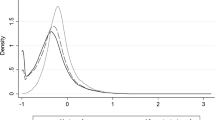Abstract
When estimating earnings equations for men in the United States, a dichotomous variable for whether or not the man is currently married is often included as a regressor. The coefficient estimate for this variable is most usually large and significant. However, there is rarely much discussion of the marriage effect. This effect is central to this study, which contributes to the understanding of this statistical association in two ways. First, it shows that the relationship exists in almost all of the fourteen developed countries examined and across several different time periods. Controlling for age, and, when available, education, race/ethnicity, hours worked, and location, marriage differences in annual earnings in favor of currently married males range from 0% to 30%. Second, it finds that there are important differences between those who are separated, divorced, widowed, and never married.
Similar content being viewed by others
References
Bartlett RL, Callahan C (1984) Wage determination and marital status: Another look. Industrial Relations 23 (Winter):90–96
Becker GS (1981) A treatise on the family. Harvard University Press, Cambridge
Cohen Y, Yitchak H (19910) Why do married men earn more than unmarried men? Soc Sci Res 20:29–44
Griliches Z (1976) Wages of very young men. J Polit Econ 84(2):569–585
Hill MS (1979) The wage effects of marital status and children. J Human Resources 14(Fall): 579–594
Korenman SD, Neumark D (1991) Does marriage really make men more productive? J Human Resources 26(2):282–307
Merkle L, Zimmermann KF (1992) The demographics of labor turnover: A comparison of ordinal probit and censored count data models. Recherches Economiques de Louvain 58:283–307
Smeeding T et al. (1988) Luxembourg Income Study Information Guide. Luxembourg Income Study Working Paper Series Number 7
Wagner J, Lorenz W (1988) An international comparison of the rates of return to human capital: Evidence from five countries. Luxembourg Income Study Working Paper Series Number 23
White H (1980) A heteroskedasticity-consistent covariance matrix estimator and a direct test for heteroskedasticity. Econometrica 48(4):817–831
Author information
Authors and Affiliations
Additional information
I am grateful for comments by John Bound, David Lam, Tom Maloney, Tim Waidmann, participants in the Economic Demography Seminar at the University of Michigan, an anonymous referee, and the editor. I also thank the staff of the Luxembourg Income Study for facilitating my use of their data base. Supplemental tables are available from the author upon request.
Rights and permissions
About this article
Cite this article
Schoeni, R.F. Marital status and earnings in developed countries. J Popul Econ 8, 351–359 (1995). https://doi.org/10.1007/BF00180873
Received:
Accepted:
Issue Date:
DOI: https://doi.org/10.1007/BF00180873




